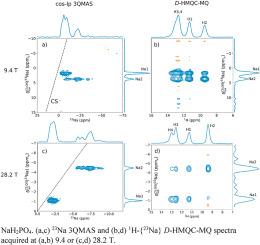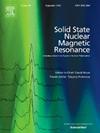利用多量子过滤通空间 D-HMQC 实验高分辨率间接探测固体中的自旋-3/2 四极核。
IF 2.4
3区 化学
Q4 CHEMISTRY, PHYSICAL
引用次数: 0
摘要
在魔角旋转(MAS)条件下进行的通空间异核相关实验可为原子间的接近性提供独特的见解。特别是,研究表明,基于两个连续相干转移(1H → I → 1H)的实验,如 D-HMQC(二极性介导的异核多量子相关),通常对通过质子间接探测具有低回旋磁比的自旋-3/2 四极核更为敏感。然而,分辨率往往会因间接维度上的二阶四极展宽而降低。为了规避这一问题,我们在 D-HMQC 序列的 t1 演化周期中加入了 MQMAS(多量子 MAS)四极滤波器,从而产生了一种名为 D-HMQC-MQ 的新型脉冲序列。在该滤波器中演化的三量子相干利用与样品旋转同步的余弦调制长脉冲进行激发和再转换,以避免间接维度的旋转边带。在此序列中,所需的相干传输路径是通过两个嵌套的齿轮相位循环(56 步)来选择的。这种高分辨率异核相关技术在通过 1H 间接检测硼酸锌水合物、NaH2PO4 和 l-组氨酸盐酸盐中的自旋-3/2 同位素(如 11B、23Na 和 35Cl)时得到了实验验证。我们的研究表明,由于 D-HMQC-MQ 实验与母 D-HMQC 实验一样,对 MAS 波动非常敏感,而 MAS 波动会产生 t1 噪声,因此只要 MAS 频率足够稳定,该实验可以在高达 28.2 T 的高磁场中应用于化学位移各向异性大于 20 ppm 的质子。本文章由计算机程序翻译,如有差异,请以英文原文为准。

High-resolution indirect detection of spin-3/2 quadrupolar nuclei in solids using multiple-quantum-filtered through-space D-HMQC experiments
Through-space heteronuclear correlation experiments under magic-angle spinning (MAS) conditions can provide unique insights into inter-atomic proximities. In particular, it has been shown that experiments based on two consecutive coherence transfers, 1H → I → 1H, like D-HMQC (dipolar-mediated heteronuclear multiple-quantum correlation), are usually more sensitive for the indirect detection via protons of spin-3/2 quadrupolar nuclei with low gyromagnetic ratio. Nevertheless, the resolution is often decreased by the second-order quadrupolar broadening along the indirect dimension. To circumvent this issue, we incorporate an MQMAS (multiple-quantum MAS) quadrupolar filter into the t1 evolution period of the D-HMQC sequence, which results in a novel pulse sequence called D-HMQC-MQ. The triple-quantum coherences evolving during this filter are excited and reconverted using cosine-modulated long-pulses synchronized with the sample rotation to avoid spinning sidebands in the indirect dimension. The desired coherence transfer pathways during this sequence are selected using two nested cogwheel phase cycles with 56 steps. This high-resolution heteronuclear correlation technique is demonstrated experimentally for the indirect detection via 1H of spin-3/2 isotopes, such as 11B, 23Na and 35Cl, in zinc borate hydrate, NaH2PO4 and l-histidine hydrochloride, respectively. We show that this experiment can be applied at high magnetic fields up to 28.2 T for protons subject to chemical shift anisotropies larger than 20 ppm, provided the MAS frequency is sufficiently stable since the D-HMQC-MQ experiment, like the parent D-HMQC, is sensitive to MAS fluctuations, which can produce t1-noise.
求助全文
通过发布文献求助,成功后即可免费获取论文全文。
去求助
来源期刊
CiteScore
5.30
自引率
9.40%
发文量
42
审稿时长
72 days
期刊介绍:
The journal Solid State Nuclear Magnetic Resonance publishes original manuscripts of high scientific quality dealing with all experimental and theoretical aspects of solid state NMR. This includes advances in instrumentation, development of new experimental techniques and methodology, new theoretical insights, new data processing and simulation methods, and original applications of established or novel methods to scientific problems.

 求助内容:
求助内容: 应助结果提醒方式:
应助结果提醒方式:


